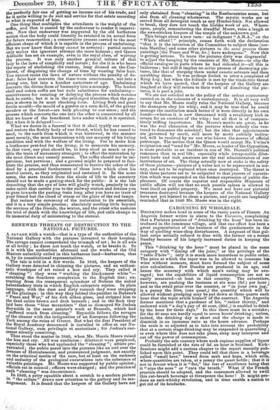RENEWED THREATS OF DESTRUCTION TO THE NATIONAL PICTURES.
A SAVAGE with a watch—that is a type of the authorities of the National Gallery with the pictures intrusted to their keeping. The savage cannot comprehend the triumph of art; he is all awe or all levity ; he dares not touch the watch, or he breaks it. So it is with the authorities aforesaid and the works of the Old Masters unluckily exiled in this barbarous land—barbarous, that is, by its constitutional representatives.
The tale is told in a few words. In 1846, the keepers of the Gallery were detected in skinning the pictures, and an enthusi- astic worshiper of art raised a hue and cry. They called it "cleaning " : they were " washing the blackamoor white"— scrubbing the Southern complexion to the English tint ; ex- tracting from the transparent splendour of Rubens the naked haberdashery tints in which English colourists rejoice. In plain language, with the dust and dirty varnish they were stripping of the glazings : in this way they robbed the panther in Rubens's " Peace and War," of his rich silken gloss, and stripped him to the dead calico brown and drab beneath ; and in the flesh they laid bare those "blue mezzotints " that so dismayed Sir Joshua Reynolds in the same painter's work at Brussels, which had "suffered much from cleaning." Reynolds follows the ravages of the cleaner with the indignation of an European following the Turk among the ruins of Greece. But what the first President of the Royal Academy denounced is installed in office at our Na- Lionel Gallery, cum privilegio et auctoritate ; Sir Joshua's suc- cessor silently conniving.
Thus stood the matter in 1846, when Mr. Morris Moore raised the hue and cry. All was confusion : dilettanti were perplexed, especially, those who had applauded the " cleaning "; thists pre- varicated; the public pored into the pictures like an owl over the frescoes of Herculaneum, and pronounced judgment, not exactly on the artistical merits of the case, but at least on the rashness and audacity of the geological excavations into the substance of valuable paintings. Mr. Moore was supported by public opinion ; officials sat in council ; officers were changed ; and the practice of such "cleaning" was discontinued. In 1849, a petty squabble about a scratch to a modern picture in"the cellars" draws new attention to the gallery and its ma- nagement. It is found that the keepers of the Gallery have not
only abstained from "cleaning" in the Eastlacustrine sense, but also from all cleaning whatsoever. The mystic works are as sacred from all detergent touch as any Hindoo fakir. Not allowed to break, they dare not touch the lifelike work of art. Where- upon, people, remembering the dreadful Moore, raise a laugh at the awe-stricken keepers of the temple of the unknown god.
This brings about a new turn: an indignant " A.R.A.," on the "Who's afraid ? " principle, comes forth with the declaration "that it is the intention of the Committee to subject these [cer- tain Murillos] and some other pictures to the same process those paintings [the Peace and War, &c.] have undergone." Now this is getting serious. To leave the pictures dirty was disgraceful to adjust the hanging by the censures of Mr. Moore—to clip the official catalogue in parts where he had ridiculed it—all this is ludicrous ; but still it implies no active process of destroying pic- tures, like that of steeping them under caustic solvents and then scrubbing them. It was perhaps foolish to utter a complaint of King Log; but when the ridicule is met by the vindictive threat which we have quoted, that if the keepers of the Gallery are laughed at they will return to their work of dissolving the pic- tures, it is past a joke.
We are not satisfied as to the policy of the ardent controversy carried on in the columns of a contemporary. It is all very well to say that Mr. Moore really rules the National Gallery, because the managers obey his whip; and it, may be true that he could manage the institution much better if it were directly in his own hands—whereas it is now threatened with a retaliatory kick in return for an overdose of the whip : but all that is of compara- tively trifling importance. Mr. Moore's merits are great, as he was the real champion of the pictures when nobody else ven- tured to denounce the mischief; but the idea that appointments are :governed by merit, still more by merit publicly indica- ted, will be received by no one who knows the course of official patronage. The notion that the Queen would accept Mr. Uwins's resignation and "send for" Mr. Moore, as leader of the Opposition, is more probable as an incident in one of Mr. Disraeli's political romances than in real life; especially while irresponsible dilet- tanti lords and rich amateurs are the real administrators of our institutions of art. The thing actually now at stake is the safety of these pictures—pictures of a value not to be represented in mo- ney, and not to be replaced when once destroyed. The threat is that these pictures are to be subjected to that process of excoria- tion which was suspended on the former expression of public dis- pleasure. Of course the superior and responsible Ministers of public affairs will see that no such puerile spleen is allowed to vent itself on public property. We must not have our pictorial treasures destroyed because the keepers of the National Gallery have not yet learned to clean a picture, and people are laughably reminded that in 1846 Mr. Moore was in the right.


























 Previous page
Previous page